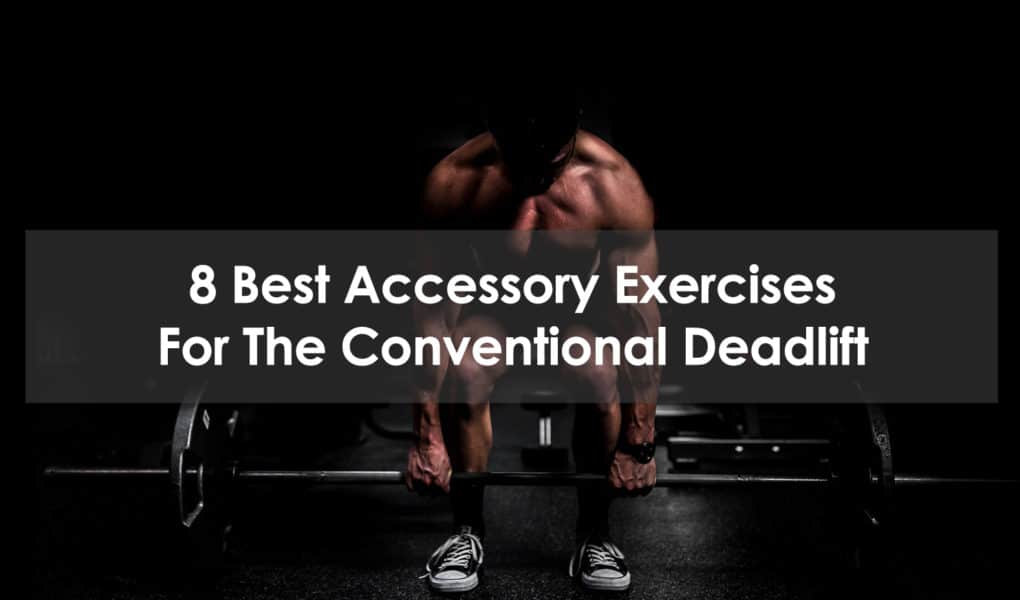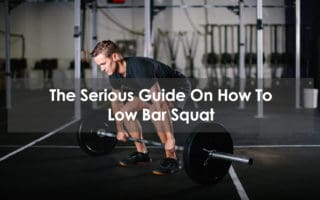Regular deadlifts are a fundamental compound exercise that is great for building strength and power. To get good at conventional deadlifts, however, you need to be strong all over the body. Most deadlifters have a weakness that prevents them from reaching their full potential on conventional deadlifts.
In this article, I’ll lay out 8 essential accessory exercises to help you plug your gaps and get a stronger deadlift.
1. Lat Pull In
Why it’s a great accessory move
The lat pull in is a fantastic exercise to strengthen the lat muscles and upper back muscles. Unlike standard lat pulldowns, the unique angle of pull works the lats through their complete range of motion and direction of muscle fiber.
Equipment used
Cable pulley machine
Step-by-step how-to
1. Set a flat bench in front of a cable pulley machine, about three feet from it. Set the pulley to about 3 stops short of its highest level.
2. Sit on the bench and grab the handle with your right hand. Your arms should be at around a 30-degree angle.
3. Pull in and down toward your hip. Turn your torso toward the hip as you do so.
4. Slowly return to the start position.
Tips
Do all reps on one side before doing the other side. Be sure to pull through a full range of motion. Maintain a neutral spine through the entire movement.
2. Hip Thrust
Why it’s a great accessory move
The gluteus maximus is the largest and strongest muscle in your body. It plays a key part in the deadlift pulling action. Simply put, the stronger your glutes, the bigger your deadlift. This is a good exercise for glute growth and strength.
Equipment used
Resistance exercise band
Step-by-step how-to
1. Lie on the floor on your back with your knees bent and a thick resistance band around your mid-thigh area.
2. With your hands on the floor, thrust your hips into the air as high as you can.
3. Lower and repeat.
Tips
Squeeze your glutes tightly in the top hip hinge position.
3. Rack Pull
Why it’s a great accessory move
The rack pull focuses on the middle portion of the deadlift pull. It is a great move to help you get past a sticking point when performing heavy deadlifts.
Equipment used
Barbell, power rack
Step-by-step how-to
1. Load a barbell on a power rack with the bar sitting at your mid-shin level on a safety bar.
2. Stand in front of the bar with a conventional stance and come down to grab it with a shoulder-width reverse grip.
3. Pull the bar up to a standing position.
4. Lower to the rack safety bar and then move directly into your next rep.
Tips
Maintain a neutral spine throughout the movement. Do not pause between reps. Pull your shoulder blades back and maintain a strong core throughout the entire movement.
5. Straight Leg Deadlift
Why it’s a great accessory move
A couple of common weak points for most people when deadlifting are the hamstrings and the lower back. The straight leg deadlift will help to overcome those deficits to allow you to lift increasingly heavy deadlift loads.
Equipment used
Olympic barbell
Step-by-step how-to
1. Stand in front of a loaded Olympic barbell with your mid feet under the bar. Come down to grab the bar with a reverse grip just a little wider than shoulder-width.
2. Bring the bar up to a starting position with the bar at a mid-shin level.
3. Without bending your knees pull the bar up to a full standing position.
4. Lower back down to mid-shin level slowly, keeping your legs straight.
Tips
Do not round your back; keep looking directly ahead and maintain a tight core. Stop just short of the lockout position in the top-end range to maintain constant tension. Pull your shoulder blades back in the top position.
6. T-Bar Row
Why it’s a great accessory move
The T-Bar row will build thickness, strength, and power through the mid-back. This will help provide the critical pulling power through the middle part of the conventional deadlift motion so you can lift heavier weights.
Equipment used
T-bar row bar.
Step-by-step how-to
1. Straddle the t-bar row bar and take hold the v-grip handle. Your knees should be slightly bent, arms fully extended and eyes looking directly ahead.
2. Pull the bar directly up to your mid-chest.
3. Lower under control to the starting position.
4. Do 3 sets of 6-12 reps.
Tips
Squeeze your mid-back muscles in the top position, pausing slightly. Do not allow momentum to do the lifting for you.
7. Forearm Curls
Why it’s a great accessory move
The forearms take a huge load when you are deadlifting with heavy weights. As a result, they are often the weak link that stops people from achieving their deadlifting potential. strengthening your forearm muscles with forearm curls will help to correct this problem.
Equipment used
Barbell
Step-by-step how-to
1. Sit on your knees side on a flat bench with a barbell in your hands. Put forearms on the bench, palms up, with your hands, and the bar rest over the bench. Your pinkies should be about six inches apart.
2. Roll the bar down your finger as far as you can. Now pull your wrist in to bring the bar up as high as you can.
3. Do 3 sets of 12-15 reps.
Tips
Use a relatively light weight that will allow you to do higher reps.
8. Hand Gripper
Why it’s a great accessory move
The hand gripper is a spring-like device that strengthens your wrists and forearm muscles. This will help to overcome a weak link in the deadlift exercise.
Equipment used
Hand Gripper
Step-by-step how-to
1. Hold a hand gripper in your right hand.
2. Squeeze the gripper and hold a 2 seconds.
3. Release the spring and repeat.
4. Do 3 sets of 15-20 reps on each hand.
Tips
As an alternative exercise, hold the hand gripper contracted position for as long as you can.
9. Deficit Deadlifts
Why it’s a great accessory move
The deficit deadlift, also called block pulls, has you standing on an elevated surface when you deadlift. As a result, you are able to execute deeper deadlifts. This teaches you to push your feet into the floor when you are deadlifting, allowing you to lift maximal weights. This exercise will also produce a deep stretch through the hamstrings.
Equipment used
Barbell, Platform
Step-by-step how-to
1. Place a 5-inch platform in front of an Olympic bar and stand upon it.
2. Come down to grab the barbell with a shoulder-width overhand grip.
3. Pull the bar up to full extension by driving your feet into the floor.
4. Do 3 sets of 10-15 repetitions.
Tips
Be sure to move through the entire range of motion on this exercise. Keep your lumbar spine in a neutral position.
10. Banded Deadlift
Why it’s a great accessory move
The band deadlift allows you to practice your deadlift technique at home. It also provides a unique type of resistance that gets harder the higher you come up. This will help you get a stronger conventional deadlift max.
Equipment used
Barbell
Step-by-step how-to
1. Stand with feet hip with apart and a resistance exercise band under your feet. Grab the band in both hands at your sides. Adjust so the band is taut.
2. Come down to shin level as your start position. Now pull the bad up to full extension. lower and repeat.
3. Do moderate rep ranges between 12-20 reps.
Tips
You may have to move your legs wider apart to keep the band taut. Keep the lumbar spine in a neutral position.
Final Thoughts
You now have 8 excellent regular deadlift accessory exercises for deadlifts that will effectively plug your deficits to allow you to be a stronger, more powerful deadlifter. Use two or three of these deadlift assistance exercises each week on your non-deadlifting days and you will be a more powerful, confident deadlifter.
Frequently Asked Questions
What muscles does the deadlift work?
The major muscle groups worked with the regular deadlift work your spinal erectors, hamstrings, glutes, latissimus dorsi, rhomboids, and trapezius muscles. When you do the Romanian deadlift or the stiff-legged deadlift, there will be more hamstring and lower back involvement.
What should feel sore after doing deadlifts?
After a deadlift workout, you should feel some muscular soreness in the hamstrings and glutes as well as in the lower back.
What are some other good exercises for the back and hamstrings?
To get more variety in your back training, I recommend doing such deadlift variations as Romanian deadlifts, the trap bar deadlift, snatch grip deadlift, wide grip deadlift, sumo deadlift, towel deadlift, knee deadlift, interval deadlifts, pause deadlifts, as well as alternative exercises like the barbell row, hyper – extensions, leg curls as well as neck curls, the barbell curl, incline curl and close grip bench press.







